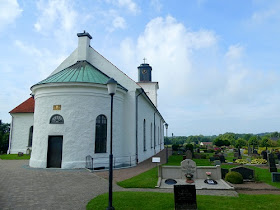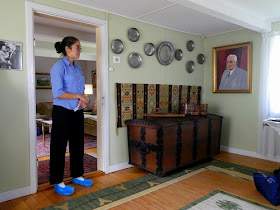'Two roles - two worlds,' announces this spread in a programme for one of Birgit Nilsson's local events in Båstad on the Bjäre Peninsula, southwest Sweden, which I was so lucky to visit this summer for the Birgit Nilsson Days. On my return, I eagerly read, finally, from cover to cover La Nilsson - My Life in Music the autobiography translated into English, and handsomely republished (though with rather too many typos) by Verlag für moderne Kunst,Vienna.
Part of Birgit's abundant legacy - I'll call her that, as do the good museum folk of her family home, since I feel in an odd way I know her, and not as some ossified legend - to have allowed music lovers like me to experience her roots in the mostly happy, if physically tough, farm work which grounded her for life. And as she tells her story, there is no personality split, despite the superhuman talent she had as one of the greatest singers of the 20th century (no need even to qualify that with 'one of the greatest Wagner and Strauss singers' - I've been listening to her recently in Scandinavian song, and she's consummate there too).
The second chapter, 'When the little one came into the world,' gives as beguiling an account of a rural childhood as Carl Nielsen's, though Birgit's circumstances were far from poor, and she was an only child, rather than one of 12 (the Danish composer's situation) or nine (the case with her father Nils). Most folk I met around the locale were delightful, natural and very down to earth. This is the farmstead where Birgit spent the first year of her life before moving to the ensemble now housing the museum.
The first of our walking expeditions - see the Hovs Hallar blog entry for the second - was an admirably signposted trail in the footsteps, or more often the bike tracks, of young Birgit.
Ingrid, aforementioned in that previous entry, was our guide, but I very
much liked the way you could (if you had a sophisticated phone, which I
certainly don't) access carefully chosen music sung by oour versatile heroine at various stopping
posts. The most charming was in front of a hillock where young Birgit joined her friends in al fresco dancing - a polka and a folksong were the choices. They put a spring in our step as we walked on.
The route led along minor roads and farm tracks through gently undulating landscapes with distant views of the sea and the Danish-style church at Hov
and eventually to the bigger edifice at Västra Karup where Birgit's formative choral training took place, and where all this year's concerts of the Birgit Nilsson Days took place.
The diva always returned to give concerts to the locals
and also to visit her parents' grave. Relations with her father were not always easy - though he bought her a house organ when she was a young girl, the idea that the natural heir to the farm, who should marry a strong man and settle there, wanted to go on to study singing was abhorrent. He gave her not a penny for her studies in Stockholm, but fortunately her mother had some money of her own. In the house-museum, we heard a recording of Stina Nilsson singing, made at the fair in Gothenburg - not just a natural voice, but also a professional-sounding one, very lovely. Lucky how posterity preserved that. In later years, Nils inevitably became very proud of his world-famous daughter.
So this was always the spot, right by the church - no special privileges for La Nilsson, who also chose to be buried there (much to Vienna's disappointment) alongside her beloved husband of 55 years, Bertil Niklasson. Though she refers to him throughout the autobiography, Birgit leaves their story until the last and, by implication, the most important chapter. The down-to-earth portrait of a marriage, not sparing of either her or Bertil's faults, is as much of a gem as any of the other highlights in the book. Forgive me if I don't show the full inscriptions which place them both equally on the plot in front of the parents' headstone (she gets the picture, though).
It's not my intention to follow the extraordinary Nilsson story through, and there are way too many fascinating insights in the autobiography to quote (not least on how the singing voice ought to work). One thing especially struck me, though: how artists at the highest level can be professional when it comes to themselves, but totally the opposite in often abysmal attitudes to their fellow musicians. The account of lessons at Stockholm's Royal Academy of Music with Scottish one-time famous tenor Joseph Hislop is a case in point of a teacher nearly wrecking a young voice, applying deadly pressure to the vocal chords, and dealing out devastating snobbery ('Birgit should be aware that it is not really possible for a farm girl to become a singer'). This photo of Birgit around that time shows she was not one to be deterred, though the effect was temporarily devastating.
Simply gobsmacking, and often very funny to us, though clearly not to the unfortunates under his baton, is the behavious of Herbert von Karajan as reported here. Quite often, I'm told, conductors ask for pianissimos from their singers in rehearsals, and then conduct mezzo forte in performance because they can't help it. Karajan, Nilsson observes, went for loud in performance quite deliberately, having asked for the same quiet dynamics from singers earlier. And the performers would often be kept waiting for up to 45 minutes in morning rehearsals, only to be told that the 'Maestro' was held up - they had to come back in the evenings.
In Vienna and New York, we read, Karajan fancied himself an expert in lighting his own Wagner productions (in this sphere he was absolutely an amateur). The Vienna Philharmonic was more than a little piqued that Karajan had granted it two rehearsals compared to 80 for the lighting. 'The technical personnel...decided, in their own charming, Viennese way to teach him a lesson in giving him a laurel wreath to celebrate the 75th lighting rehearsal'. Can you imagine how ludicrous the vain creature looked, raised up with a light shining on him (the lucky one), baton in one hand, telephone to give lighting cues in the other?
This splendid piece of satirical wear, a miner's helmet with red light for a Brünnhilde groping in the dark, now on display among the items on Nilsson's dressing table and mirror in the museum, was sent to Nilsson on the evening of her Walküre premiere at the Met. Karajan wanted to know the sender but never found out. We learn from the afterword to the new edition of La Nilsson that the writer, high-up Met secretary Peggy Tueller who became great friends with Birgit, was the culprit. The Valkyrie duly modelled it in her dressing room (though I don't think she went on stage in it during a rehearsal with Karajan, as has also been asserted).
As I wrote in the piece for The Arts Desk, I've never laughed more going round a museum: Nilsson had a wonderful sense of humour to counter all the weird flummery of the opera world. I wonder what she thought of all these dolls, sent by one fan, though she became firm friends with the lady and godmother to her son.
Warm and honest with genuine fans, Nilsson recalls the less funny side in her autobiography: a long and terrifying story of a glamorous stalker which might make a good subject for a film, a play or even an opera. I'll leave you to read about that.
Anyway, her reading was eclectic - or maybe she just displayed the books given to her in the farmhouse which became a summer home. Did she ever learn any of The World's Best Dirty Jokes?
While you're free to wander at will through the museum, in the converted cow barn, the house can be seen by guided tour. Our young guide Klara, a perfect English speaker with real flair in delivery giving her first tour in the language, couldn't have been nicer, and in that she was no different from all the staff who work at the museum. That's a portrait of Nils on the wall, by the way, next to some traditional Swedish furniture and fabrics.
Just a few more shots from the farmhouse: the kitchen
which also has a copy of the Met Cookbook open at the page of Birgit's recipe for gravad lax; two of her cakes are also available from the excellent cafe (where the pigs used to be kept, appropriatedly enough); and a view of the piano surmounted by photos - I love the treated one, top row left, of a Stockholm debut as Agathe.
So thankful that the house organ given by dad to talented young daughter is on display in the pastor's house at the Boarp Museum of Local History above Båstad,
because otherwise we might not have discovered this delightful open-air collection of buildings or been treated to a very special tea in a cosy back room of the wooden building in which refreshments are served. My gorgeous friend Pia was doing up a house only fifteen minutes up the coast by train , and she joined us for the afternoon. I love this pic of her pouring coffee while the splendid lady who spoiled us stands in the background.
I need to return to Båstad for a blog entry about the supremely beautiful church there, another local venue for Birgit of Bjärehalvön. A final word on the autobiography: it's so mich more than a series of anecdotes. And while our incorruptible heroine does not spare the timewasters and troublemakers of the operatic world, she is infallibly generous about the majority of her colleagues (even Karajan is granted the ability, when he feels like it, to pull something absolutely sensational out of his oversized hat). And, I'm sure, absolutely truthful.
By way of coda, since we haven't seen much of Birgit in the roles for which she was most celebrated, see how different she could look on stage according to costume and make-up. The cover of the Decca Salome - although I have it on CD, I couldn't resist picking up the LP box set in a charity shop the other week - has always been a hoot, an audition before its time for RuPaul's Drag Race
but then look at my favourite glamour shot of our heroine in the same role. Very Emma Peel as played by Diana Rigg in The Avengers, don't you think?
The museum sells postcards and even spectacle cloths with this on. Needless to say, I bought four.






















How lovely to read your account of la Nilsson's autobiography and Museum! Want to go next time. Have only visited the grave...I think she must have been such fun to know. Love that pic of her asxSalome! XxAnn-Sofi (who is, apparently, a very distant relative of the diva, on my father's side. He grew up in Vastra Karup!)
ReplyDeleteGitte at the Museum is also related, and in her case you can see it. At any rate her open welcome is so exactly in the spirit of Birgit - it all seems to have been worked out by the great lady from beyond the grave. And AT the grave they often consult her on what to do in certain circumstances...She is so THERE.
ReplyDeleteSo your father must have attended the same church! Can't work out if there could have been any overlap, with both there at the same time. As she also went back for recitals, it's possible, don't you think? As I wrote on TAD, the church is enormous, with the altar in the middle and three wings of seats - expanded in the 19th century because church attendance became compulsory for the entire community.
Thanks for another wonderful article about Birgit and your visit to Bjärehalvön! I knew you would love her autobiography. It is certainly a good read - which I keep telling people participating in my guided tours. Many of them are not very interested in opera, but people do not need to be totally addicted to opera to appreciate her autobiography. It goes without saying that "La Nilsson" is even better in Swedish, as some of her great sense of humour is lost in translation. Still, it is a fantastic and often humorous way of finding out more about her personal and professional life. If I may generalize, people in Sweden really love British humour. It is great to see that it works the other way around as well... Birgit's sense of humour is displayed in so many tv shows and interviews. I am sure you have seen them all or most of them, enjoying her unique combination of star quality and down-to-earth attitude.
ReplyDeleteDid you know that Birgit made a brief and unexpected appearance in crime fiction too? I started thinking about an old novel named "Ofärd i huset bor" by Maria Lang, probably not translated into English. There Birgit Nilsson sings in "Die Walküre" together with Set Svanholm and one of the fictional characters, a young singer called Camilla making her debut as Sieglinde. The main character Christer Wijk, a detective, is unavoidably delayed and misses Birgit Nilsson's "Hojotoho". He thinks he is allergic to Wagner, but he cannot help getting mesmerised by Birgit's seemingly effortless performance. Two of Maria Lang's novels are set at the Royal Opera House in Stockholm. She was obviously a great fan of opera herself. If I remember correctly Birgit is not included in the other novel. When celebrities appear in a film as themselves I believe the word describing this is a cameo or a cameo role/appearance. Is it also possible to use it about literature?
Fascinating about the star and the novel. What a pity there isn't an English translation. The best novel I know, by a long way, about the artist's life as represented in a Wagnerian soprano is Willa Cather's 'The Song of the Lark', a big, billowing epic full of thought-provoking ideas.
ReplyDelete'Cameo' would be correct, but I'm not sure it's true of Kirsten Flagstad's appearance in 'The Big Broadcast of 1938', because that's a variety show in which La Flagstad has the full support of the Met Orchestra on a cruise...'special guest appearance', in that case.
As for Nordic folk loving the British SOH, I sat next to the CEO of the Bergen Philharmonic at a meal after a concert in Berlin's Philharmonie, and at one point he said 'I know naaathing'. Of course I knew it was Manuel in Fawlty Towers, and he told me that the Norwegians, with their excellent grasp of English, live off British comedy on TV.
Excellent David. I have ready the biography .She was so down to earth. I had planned to visit her museum sometime but yu have done it for me!! Very interesting
ReplyDeleteNo, Liam, you absolutely have to go and see for yourself. Such a beautiful part of Sweden, indeed of the world, in a rather gentle way, and so much to discover in the vicinity.
ReplyDeleteThank you for the detailed post! Birgit is my new idol and I'm reading about her and listening to her a lot. I've always been doing music (heavy metal) but now I'm also getting into opera, and learning how to read sheet music. There is a certain sadness getting into the world of opera, as I mostly enjoy the old singers who are now gone. But in Birgit's case she left a great legacy and not much to be sad about regarding her (except that she's gone). I am glad that she had such a long and amazing career and was such a good person.
ReplyDeleteThere will never be another Nilsson, but we're not short of potentially great singers today. Try Lise Davidsen - she's the real deal, and a natural on stage; I've seen her in uninteresting productions where she's still dramatically riveting.
ReplyDelete